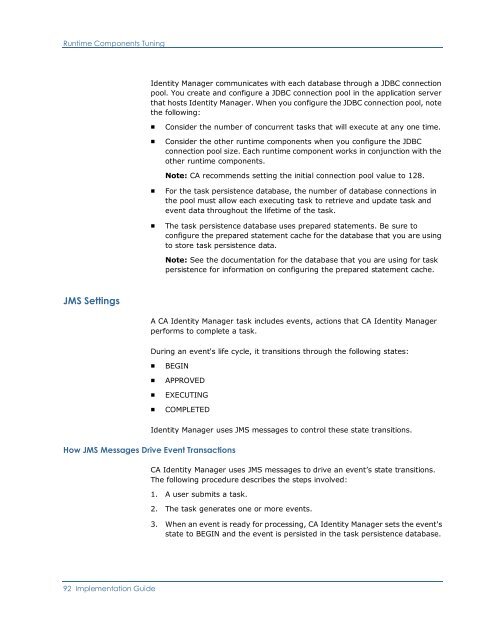CA Identity Manager Implementation Guide - CA Technologies
CA Identity Manager Implementation Guide - CA Technologies
CA Identity Manager Implementation Guide - CA Technologies
- No tags were found...
You also want an ePaper? Increase the reach of your titles
YUMPU automatically turns print PDFs into web optimized ePapers that Google loves.
Runtime Components Tuning<strong>Identity</strong> <strong>Manager</strong> communicates with each database through a JDBC connectionpool. You create and configure a JDBC connection pool in the application serverthat hosts <strong>Identity</strong> <strong>Manager</strong>. When you configure the JDBC connection pool, notethe following:■■Consider the number of concurrent tasks that will execute at any one time.Consider the other runtime components when you configure the JDBCconnection pool size. Each runtime component works in conjunction with theother runtime components.Note: <strong>CA</strong> recommends setting the initial connection pool value to 128.■■For the task persistence database, the number of database connections inthe pool must allow each executing task to retrieve and update task andevent data throughout the lifetime of the task.The task persistence database uses prepared statements. Be sure toconfigure the prepared statement cache for the database that you are usingto store task persistence data.Note: See the documentation for the database that you are using for taskpersistence for information on configuring the prepared statement cache.JMS SettingsA <strong>CA</strong> <strong>Identity</strong> <strong>Manager</strong> task includes events, actions that <strong>CA</strong> <strong>Identity</strong> <strong>Manager</strong>performs to complete a task.During an event's life cycle, it transitions through the following states:■■■■BEGINAPPROVEDEXECUTINGCOMPLETEDHow JMS Messages Drive Event Transactions<strong>Identity</strong> <strong>Manager</strong> uses JMS messages to control these state transitions.<strong>CA</strong> <strong>Identity</strong> <strong>Manager</strong> uses JMS messages to drive an event’s state transitions.The following procedure describes the steps involved:1. A user submits a task.2. The task generates one or more events.3. When an event is ready for processing, <strong>CA</strong> <strong>Identity</strong> <strong>Manager</strong> sets the event'sstate to BEGIN and the event is persisted in the task persistence database.92 <strong>Implementation</strong> <strong>Guide</strong>
















